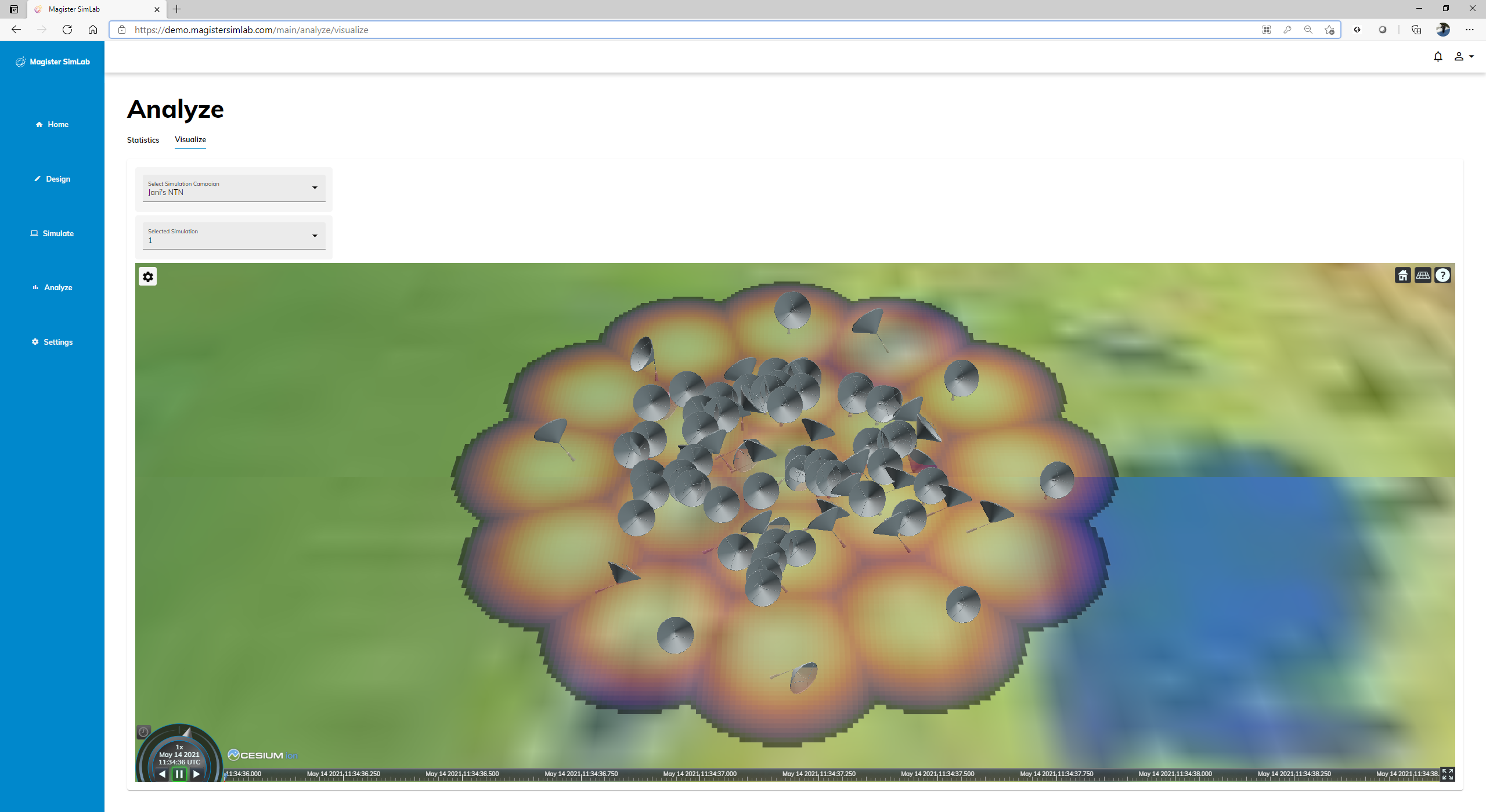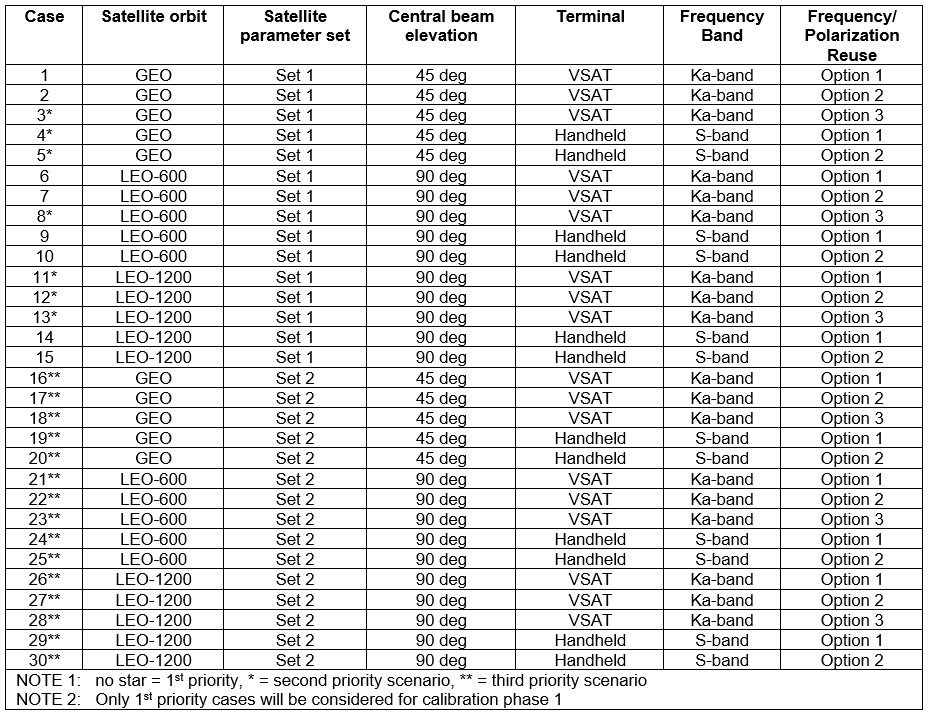5G NTN simulator is system/network level simulator for 3GPP 5G Non-Terrestrial Network (NTN) evaluations. NTN simulator is based on Network Simulator 3 (ns-3) and its 5G enhancements designed by Centre Tecnològic de Telecomunicacions de Catalunya (CTTC) in 5G LENA extensions.
3rd Generation Partnership Project (3GPP) has been working on the 5G Non-Terrestrial Networks (NTN) from 2016 onwards . First with a study item, and then with a “Solutions for NR to support non-terrestrial networks (NTN)” work item (WI) in 3GPP Release 17. WI targets developing technical specifications to support transparent payload-based spaceborne systems, i.e., Low Earth Orbit (LEO) and Geostationary Earth Orbit (GEO) scenarios. But the specifications would support also different airborne scenarios, such as Unmanned Aerial Systems (UAS) and High-Altitude Platform Station (HAPS) systems.
NTN simulator is targeted at being used to support NTN standardization in 3GPP RAN. It implements the NTN channel model described in TR 38.811 and evaluation scenarios presented in TR 38.821. A transparent satellite payload has been assumed, where gNB is on the ground and satellite acts as an analogue radio frequency repeater. The feeder link is assumed to be ideal and only increases the propagation delay. However, NTN simulator is implemented in a way that modelling of regenerative payload (gNB onboard the satellite) is also possible. Frequency Division Duplex (FDD) is a baseline assumption for NTN, but the simulator has also support for Time Division Duplex (TDD).

TR 38.821 describes 30 calibration scenarios for NTN evaluations. They differ in terms of:
Satellite orbit: Geostationary Earth Orbit (GEO), Low Earth Orbit (LEO) at 600 km and 1200 km altitudes. GEO scenarios assume 45 degrees and LEO scenarios 90 degrees central beam elevation angles.
Frequency band: S- or Ka-band
UE antenna: Handheld (omnidirectional antenna) or Very Small Aperture Terminal (VSAT) antenna
Baseline link budget parameter set: so called Set-1 and Set-2 defined in TR 38.821 Section 6.1.1.1.
Frequency reuse scheme: full frequency reuse, 3 frequency color reuse, 2 frequency color + 2 polarization reuse
All of the calibration scenarios are supported by the simulator.

The modeling assumptions and features:
One satellite alone: By default only one satellite is modelled with configurable number of user link beams. This is due to complexity of the simulator and related run-time requirements. However, configuration of multiple satellite scenarios is also possible.
Channel: Line-of-sight (LOS), Non line-of-sight (NLOS) or dynamic probability according to 3GPP TR 38.821.
Mobility: The default assumption of the NTN simulator is that both satellite as well as UEs are stationary. The main reasoning is that simulation times are considered to be so short that the movement of satellite does not need to be considered. However, NTN simulator supports also mobility along a pre-defined satellite orbit defined by a Two-Line Element (TLE) file as input. Also so-called Doppler mobility is supported where doppler effect with selected speed is modelled while the actual location of the nodes do not change.
Wrap-around interference: wrap around mechanism in case of single satellite simulation for intra-satellite interference modelling based on additional bore-sight beam directions causing interference on simulated center beams. One can configure how many tiers of interfering cells are created and with how many UEs per cell. Statistics do not include interfering cells.
Handover: If satellite or UEs are moving, the NTN simulator also needs to implement a connected mode handover procedure. Currently, the simulator supports baseline A3 RSRP triggered UE assisted handover model. Also initial cell selection based on RSRP is supported.
Uplink Power control (UL PC): Pathloss based open loop power control defined in TS 38.213. UL PC takes power limitations into account using so called Power Headroom (PHR) constraint as reported by UE.
Traffic models: Full (infinite) buffer and Constant Bit Rate (CBR) type UDP traffic.
RRM: HARQ with NTN enhancements e.g. increasing the number of HARQ processes and so called blind HARQ retransmissions can be mentioned as examples. ACM with adjustable BLER target and block size for error estimation.
Scheduling: Frequency Domain (FD) scheduling with Round Robin (RR) and Proportional Fair (PF) scheduling metrics. Number of scheduled users per slot configurable. HARQ feedback have priority over new data. Shuffling of resource blocks to minimize interference in the system.
RLC: Unacknowledged (UM) and Acknowledged mode (AM).
ISLs: No support
Statistics: most of them to both DL and UL direction: ACI, RX power, call TP (app & RLC), CL, UL CQI, allocation size, load, HARQ retx count, interference, MCS, Olla offset, app&RLC packet delay, packet TP, SINR per TB/PRB, SIR, SNR, TB error rates before/after HARQ, UL TX power, UL power limit.
Statistics configure include a warmup time, within which the statistics is not collected from the beginning of simulation.
References:
ESA ALIX "Support to standardisation of satellites 5G component" project, https://artes.esa.int/projects/alix.
Network Simulator 3 (ns-3), https://www.nsnam.org/
N. Patriciello, S. Lagen, B. Bojovic, L. Giupponi, An E2E Simulator for 5G NR Networks, Elsevier Simulation Modelling Practice and Theory (SIMPAT), vol. 96, 101933, Nov. 2019, DOI. Available from http://arxiv.org/abs/1911.05534.
Jani Puttonen, Lauri Sormunen, Henrik Martikainen, Sami Rantanen, Janne Kurjenniemi, "A System Simulator for 5G Non-Terrestrial Network Evaluations", 22nd IEEE International Symposium on a World of Wireless, Mobile and Multimedia Networks (#WoWMoM) conference, Workshop on Non-Terrestrial Networks in 6G Wireless, June 7–11, 2021.
3GPP TR 38.821, “Solutions for NR to support nonterrestrial networks (NTN)”, V16.0.0 (2019-12).
3GPP TR 38.811 “Study on New Radio (NR) to support nonterrestrial networks”, V15.4.0 (2020-09).
3GPP TS 38.213, “Physical layer procedures for control”, V16.4.0 (2020-12).
